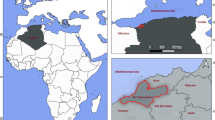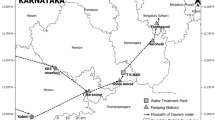Abstract
Ensuring safe drinking water is a major challenge in the southwest coastal region of Bangladesh due to the extreme intrusion of salinity in water resources. To address this issue, a range of drinking water supply systems (WSS) have been implemented in these coastal regions. These include deep tube wells (DTW), metered water (MW) as piped water supply, pond sand filters (PSF), reverse osmosis (RO), rainwater harvesting (RWH), shallow tube wells (STW), and surface water (SW) sources. The purpose of this study was to assess the sustainability of the existing WSS of the southwest coastal region of Bangladesh through the three pillars of ternary diagram approaches: social acceptability, economic viability, and technical suitability. To collect data for the assessment, a structured questionnaire survey was conducted at the local household level, along with focus group discussions (FGDs) and key informant interviews (KIIs). In addition, 160 water samples were collected from the different WSS to assess the water quality. DTW (22%), RO (20%), and MW (15%) were found to be the socially most acceptable WSS. RO, DTW, RWH, and MW ranked higher and were identified as the most sustainable WSS systems in the three-pillar approaches. Furthermore, a water quality index showed that all the WSS were classified as excellent water quality, except STW, which was categorized as very poor. RO and MW produce high-quality water and became prevalent in the study area, despite their higher costs. Overall results revealed that DTW, RO, and MW could be sustainable WSS options for the coastal area of Bangladesh.






Similar content being viewed by others
Data availability
The datasets generated during and/or analyzed during the current study are available from the corresponding author on reasonable request.
References
Abedin MA, Shaw R (2018) Constraints and co** measures of coastal community towards safe drinking water scarcity in southwestern Bangladesh. Sci Technol Disaster Risk Reduct Asia 2018:431–452. https://doi.org/10.1016/B978-0-12-812711-7.00025-0
Almeida CMVB, Barrella FA, Giannetti BF (2007) Emergetic ternary diagrams: five examples for application in environmental accounting for decision-making. J Clean Prod 15:63–74. https://doi.org/10.1016/j.jclepro.2005.07.002
Amos CC, Ahmed A, Rahman A (2020) Sustainability in water provision in rural communities: the feasibility of a village scale rainwater harvesting scheme. Water Resour Manag 34:4633–4647. https://doi.org/10.1007/s11269-020-02679-1
APHA (2005) Standard methods for the examination of water and wastewater. American Public Health Association (APHA) Washington DC, USA. https://www.awwa.org/Publications/Standard-Methods. Accessed 16 Aug 2023
Bari QH, Raihan A, Hossain MS, Tanny SA (2016) Tube in tube technique for solar desalination. In: 3rd International conference on civil engineering for sustainable development (ICCESD), 12–14 February 2016, KUET, Khulna, Bangladesh. pp 117–124. http://iccesd.com/proc_2016/Papers/ICCESD-2016-400.pdf
Bari QH, Shafiquzzaman M, Bari QS (2022) Success rate in sinking deep tube-wells to search new water source in the northern periphery of Khulna city. In: 6th International conference on civil engineering for sustainable development (ICCESD), 10–12 February 2022, KUET, Khulna, Bangladesh. pp 1–9. http://iccesd.com/proc_2022/Papers/ENV-4947.pdf
BBS (2011) Districts statistics of Satkhira. Statistics and Informatics Division (SID), Ministry of Planning, Government of the People’s Republic of Bangladesh. 2011. [cited 1 January November 2023]. http://203.112.218.65:8008/WebTestApplication/userfiles/Image/District%20Statistics/Satkhira.pdf. Accessed 16 Aug 2023
Biswas BK, Mandal BH (2014) Construction and evaluation of rainwater harvesting system for domestic use in a remote and rural area of Khulna, Bangladesh. Int Sch Res Not. https://doi.org/10.1155/2014/751952
Boyle T, Giurco D, Mukheibir P, Liu A, Moy C, White S, Stewart R (2013) Intelligent metering for urban water: a review. Water 5(3):1052–1081. https://doi.org/10.3390/w5031052
Brown RM, McClellan NI, Deininger RA, Tozer RG (1970) A water quality index—do we dare? Water Sew Works 117(10):339–343
Ferdausi SA, Bolkland MW (2000) Design improvement for pond sand filter. In: 26th WEDC conference (water, sanitation and hygiene: challenges of the millennium), 2000, Dhaka, Bangladesh. pp 212–215. https://wedc-knowledge.lboro.ac.uk/resources/conference/26/Ferdausi-2.pdf
Harun MAYA, Kabir GMM (2013) Evaluating pond sand filter as sustainable drinking water supplier in the southwest coastal region of Bangladesh. Appl Water Sci 3:161–166. https://doi.org/10.1007/s13201-012-0069-7
Hasan MM, Shafiquzzaman M, Nakajima J, Bari QH (2012) Application of a simple arsenic removal filter in a rural area of Bangladesh. Water Sci Technol Water Supply 125:658–665. https://doi.org/10.2166/ws.2012.039
Howarth RJ (1996) Sources for a history of the ternary diagram. Br J Hist Sci 29(3):337–356. https://doi.org/10.1017/S000708740003449X
Islam MM, Afrin S (2020) Financial feasibility assessment of rainwater harvesting system in coastal Bangladesh considering precipitation variability due to climate change. In: 5th International conference on civil engineering for sustainable development (ICCESD), February 2020, KUET, Khulna, Bangladesh. pp 7–9. https://doi.org/10.1016/j.jenvman.2021.112507
Islam MS, Mahmud ZH, Islam MS, Saha GC, Zahid A, Ali AHMZ, Hassan MQ, Islam K, Jahan H, Hossain Y, Hasan MM, Cairncross S, Carter R, Luby SP, Cravioto A, Endtz HP, Faruque SM, Clemens JD (2016) Safe distances between groundwater-based water wells and pit latrines at different hydrogeological conditions in the Ganges Atrai floodplains of Bangladesh. J Health Popul Nutr 35(1):1–10. https://doi.org/10.1186/s41043-016-0063-z
Islam ARMT, Siddiqua MT, Zahid A, Tasnim SS, Rahman MM (2020) Drinking appraisal of coastal groundwater in Bangladesh: an approach of multi-hazards towards water security and health safety. Chemosphere 255:126933. https://doi.org/10.1016/j.chemosphere.2020.126933
Kamruzzaman AKM, Ahmed F (2006) Study of performance of existing pond sand filters in different parts of Bangladesh. In: Fisher J (ed) Sustainable development of water resources, water supply and environmental sanitation: Proceedings of the 32nd WEDC international conference, Colombo, Sri Lanka, 13–17 November 2006, pp 377–380
Knight A (2007) The poor contribution of chimpanzee experiments to biomedical progress. J Appl Anim Welf Sci 10(4):281–308. https://doi.org/10.1080/10888700701555501
Mondal MS, Jalal MR, Khan M, Kumar U, Rahman R, Huq H (2013) Hydro-meteorological trends in southwest coastal bangladesh: perspectives of climate change and human interventions. Am J Climate Change 2:62–70. https://doi.org/10.4236/ajcc.2013.21007
Mondal B, Bari QH (2022) Exploring sustainable water supply system of south-western coastal region of Bangladesh: a case study in Assasuni Upazila. In: 6th International conference on civil engineering for sustainable development (ICCESD), KUET, Khulna, Bangladesh, 2022
Nardo AD, Natale MD (2010) A design support methodology for district metering of water supply networks. In: 12th Annual conference on water distribution systems analysis (WDSA) water distribution system analysis, USA. September 12–15, 2010, pp 1–16. https://doi.org/10.1061/41203(425)80
Naus FL, Burer K, van Laerhoven F, Griffioen J, Ahmed KM, Schot P (2020) Why do people remain attached to unsafe drinking water options? Quantitative evidence from southwestern Bangladesh. Water 12(2):342. https://doi.org/10.3390/w12020342
Rahman MTU, Rasheduzzaman M, Habib MA, Ahmed A, Tareq SM, Muniruzzaman SM (2017) Assessment of fresh water security in coastal Bangladesh: an insight from salinity, community perception and adaptation. Ocean Coast Manag 137:68–81. https://doi.org/10.1016/j.ocecoaman.2016.12.005
Roy K, Bari QH, Mostakim S, Argha PP (2019) Water supply history of Khulna City, In: 6th International conference on integrated solid waste & faecal sludge management in South-Asian Countries, KUET, Khulna, Bangladesh. pp 1–13
Saha R, Dey NC, Rahman M, Bhattacharya P, Rabbani GH (2019) Geogenic arsenic and microbial contamination in drinking water sources: exposure risks to the coastal population in Bangladesh. Front Environ Sci 7:57. https://doi.org/10.3389/fenvs.2019.00057
Saha P, Ashraf A, Oyshi JT et al (2021) A community-based approach to sustainable transboundary water resources management and governance in the South-West Coastal region of Bangladesh. Sustain Water Resour Manag 7:79. https://doi.org/10.1007/s40899-021-00562-4
Sakamoto M (2021) Revisiting the village where arsenic contamination of underground water was first discovered in Bangladesh: twenty-five years later. Int J Environ Res Public Health 18(1):259. https://doi.org/10.3390/ijerph18010259
Shafiuddin M, Karim MM (2003) Water Resources management in the remediation of groundwater arsenic contamination in Bangladesh. In: Murphy T, Guo Emerald Backhuys J (eds) Aquatic arsenic toxicity and treatment. Backhuys, Leiden, pp 1–17
Shammi M, Rahman MM, Islam MA, Bodrud-Doza M, Zahid A, Akter Y, Quaiyum S, Kurasaki M (2017) Spatio-temporal assessment and trend analysis of surface water salinity in the coastal region of Bangladesh. Environ Sci Pollut Res 24:14273–14290. https://doi.org/10.1007/s11356-017-8976-7
Shammi M, Rahman MM, Bondad SE, Bodrud-Doza M (2019) Impacts of salinity intrusion in community health: a review of experiences on drinking water sodium from coastal areas of Bangladesh. Healthcare 7(1):50. https://doi.org/10.3390/healthcare7010050
Shamsuzzoha M, Rasheduzzaman M, Ghosh RC (2015) Building resilience for drinking water shortages through reverse osmosis technology in coastal areas of Bangladesh. Procedia Eng 212:559–566. https://doi.org/10.1016/j.proeng.2018.01.072
Sheikh MR, Islam MS (2017) Application of ceramic filter for improvement of pond sand filter’s water quality. Am J Environ Prot 6(3):62–68. https://doi.org/10.11648/j.ajep.20170603.11
UNDP (2013) Ensuring access to safe water supply in the disaster prone coastal zone Bangladesh. [Cited 2 January 2023]. https://reliefweb.int/report/bangladesh/ensuring-access-safe-water-supply-disaster-prone-coastal-zone-bangladesh. Accessed 16 Aug 2023
WHO (2004) Occurrence of cyanobacterial toxins (microcystins) in surface waters of rural Bangladesh. [cited 2 January 2023]. https://apps.who.int/iris/bitstream/handle/10665/68699/WHO_SDE_WSH_04.06.pdf?sequence=1. Accessed 16 Aug 2023
Acknowledgements
The authors acknowledged the Environmental Engineering Laboratory officials of Khulna University of Engineering & Technology for their cordial support during water testing. Special thanks to the Ministry of Science and Technology (MoST) of the People’s Republic of Bangladesh for providing the ‘National Science and Technology (NST) Fellowship’ in this study to carry out the research work during the Postgraduate Course ‘Master of Science in Sanitation’ from the Institute of Disaster Management, Khulna University of Engineering & Technology in cooperation with IHE-Delft the Institute for Water Education, Delft, The Netherlands under Global Sanitation Graduate School (GSGS).
Author information
Authors and Affiliations
Contributions
BM conducted the survey and experiments and wrote the initial draft of the manuscript. QHB was involved in conceptualization, supervision, formal analysis, and writing—manuscript. MS was involved in data analysis, data curation, revising, editing, and writing the manuscript.
Corresponding author
Ethics declarations
Conflict of interest
The authors declare no conflict of interest associated with this study.
Additional information
Publisher's Note
Springer Nature remains neutral with regard to jurisdictional claims in published maps and institutional affiliations.
Supplementary Information
Below is the link to the electronic supplementary material.
Rights and permissions
Springer Nature or its licensor (e.g. a society or other partner) holds exclusive rights to this article under a publishing agreement with the author(s) or other rightsholder(s); author self-archiving of the accepted manuscript version of this article is solely governed by the terms of such publishing agreement and applicable law.
About this article
Cite this article
Mondal, B., Bari, Q.H. & Shafiquzzaman, M. A ternary diagram approach to evaluate the sustainability of existing water supply systems in southwest coastal Bangladesh. Sustain. Water Resour. Manag. 9, 143 (2023). https://doi.org/10.1007/s40899-023-00925-z
Received:
Accepted:
Published:
DOI: https://doi.org/10.1007/s40899-023-00925-z




